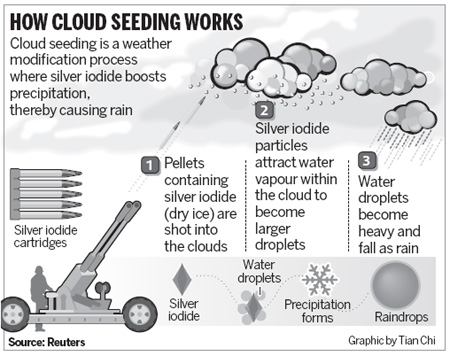Demand rising for weather modification
China will step up weather modification in key regions to help relieve drought, the director of the China Meteorological Administration has said.
 |
|
Head of China Meteorological Administration Zheng Guoguang says weather modification will raise crop yields.[China Daily] |
As drought and hailstorms pose severe threats to rural income and food supply, there is a rising demand for technology to cushion the impact, Zheng Guoguang told China Daily.
Weather modification technology has also been used to ensure clear skies for important events, and will possibly be used for the upcoming Shanghai World Expo.
Modifying weather involves seeding clouds with grains of dry ice (frozen carbon dioxide) or tiny particles of silver iodide to stimulate rainfall or dissipate the clouds. It is also used to help prevent or control forest fires and ease acute water shortages in some areas, he said.
Statistics for losses caused by natural disasters in recent years were not immediately available, but a chronic drought in 2007, the worst in a decade, caused losses of 37.4 million tons of grain, according to official statistics. The annual grain output is around 500 million tons.
Zheng said he expects weather modification projects will contribute to the country's efforts to increase grain production capacity by 50 million tons annually.
Last year, officials used artillery, rockets or planes to induce precipitation for wheat-producing areas and some other regions, thanks partly to a central government fund of 60 million yuan ($8.8 million), Zheng said. In the past, most funds for weather modification projects came from local governments.
In all, a record 840 flights were made to increase rain last year for areas spanning 3.6 million square kilometers - or roughly one-third of China's territory. Also, at least 116,000 rockets and 890,000 artillery shells were fired to alter atmospheric phenomena.
Nationwide, weather modification projects cost 910 million yuan in 2009, but helped generate output 30 times that amount, according to statistics from the Weather Modification Center.
The meteorological agency has completed research and development of weather modification core technology and equipment, a State-funded project during the 11th Five-Year Plan (2006-2010). Research will continue to be beefed up in the years to come, he said, without elaborating.
The technology was used to ensure clear skies for the grand parade of the National Day celebration last year, when the country marked the 60th anniversary of the founding of New China. It also was used to ensure rainless days for the opening and closing ceremonies of the 2008 Beijing Olympic Games, Zheng said.
The China Meteorological Administration is gearing up for weather services for the Shanghai World Expo, which opens in May, and for November's Asian Games in Guangzhou, he said.
The Shanghai event will be a challenge, as it lasts 184 days and may be affected by monsoons and high temperatures.
Weather manipulation is still a developing discipline that holds great potential, Zheng said. The country began modifying the weather on a local or regional scale in 1958.
"It is still at a 'research-and-use' stage, and there are still a lot of problems to be resolved," Zheng said.
Weather modification causes no pollution, as very few doses of dry ice or silver iodide are used, said officials from the administration's Weather Modification Center.
 |
For example, the Beijing weather modification office has for years monitored water quality in areas where modification projects took place. They found traces of silver ions in the water to be far below the national drinking water standard allowance.
 0
0 






